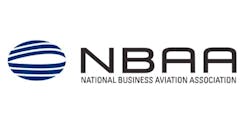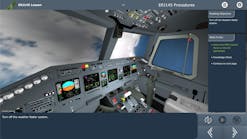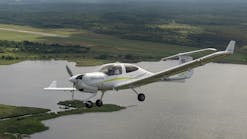My youngest son was just graduating from elementary school. My wife, Sandi, was just starting full-time teaching. She was volunteering while our three boys were still in school. My youngest son is now 41, Sandi is now retired from teaching. Wow, where has the time gone?
A little history
Early in 1988 a group got together to start a magazine to be called Aircraft Technician. Mike Murrell, was publisher, Kathy Marr, associate publisher, and Barbara Zuehlke, copy editor (our present senior editor). I was asked at a meeting in Philadelphia to participate as a columnist. It was a challenging event for all concerned. Because of the downturn in new aircraft manufacturing a need was seen for a focus on maintaining the fleet that was out in the field. Most of this initial cadre of staff are now gone except for a few, including this writer.
The inaugural issue release came in November/December 1989. Aircraft Technician’s title page said that it was: Servicing Commuter Corporate General Aviation Maintenance Professionals. It featured editorial comments from the editor and the publisher. A separate feature on Industry News was a prominent part of the magazine. Also, leading articles on Spectrometric Oil Analysis, Automated Trend Monitoring for Turbine Engines, Avionics Removal and Replacement, and Vacuum Pumps were an important part of the content.
I came aboard as a columnist and started a Staying Legal column. My initial column was titled FAA Enforcement Frenzy. The topic was a popular subject since the regulatory enforcement (legal) department of the FAA was considered to be very active at that time in pursuing enforcement proceedings against technicians and repair facilities. It is still a timely topic. One of my points at that time suggested to airmen that they keep their mouth shut when discussing possible violations with FAA inspectors. You don’t have to speak with them and in many cases what you say usually comes back to haunt you later. There is now however a variety of a Miranda warning involved in enforcement cases and other areas where you provide information to FAA for any certificates. No statute of limitations is still in effect. Be aware that anything you say can be used against you in enforcement proceedings now or in the future. Needless to say, the first thing you do after hearing of a possible violation is file a NASA report (http://asrs.arc.nasa.gov or Aviation Safety Reporting System form on line) relative to the basis of any possible violation.
Name change
The Aircraft Technician magazine title name was later changed to Aircraft Maintenance Technology, more accurately reflecting the mission.
In 1990, my friend, Bill O’Brien came aboard with inside information from his long employment with the FAA. He brought with him his popular acerbic Irish wit. He was loved by all who knew him and appreciated by all technicians who had the luck to hear one of his presentations in person. Unfortunately we lost Bill to leukemia in 2008. Other columnists followed from other industry associations.
The magazine is seen as a tribune, an unofficial defender of the rights of the individual technician and continues in this status today. When controversial issues arise on the regulatory front AMT will jump right into the mix and analyze the effects on technicians in the field. Recent examples include: training, IA renewal changes, and Pilots (and Mechanics Bill of Rights). Many new faces have come and remain on the job to continue the goal of the original founding group.
Training
One of the ongoing developments that has been fostered by Ron Donner, present editor and executive director of AMTSociety is our training seminars scheduled throughout the year at various locations around the country. These did not exist 25 five years ago. It continues the pioneering work of Tom Hendershot, initial executive director who we unfortunately lost to cancer. These seminars have been found to be a needed asset for the technician to keep informed of new developments in the field as well as new regulatory rules. The seminars can also be used by technicians to support renewal of their inspection authority.
Looking back
When we started AMT, general aviation was in a mild recession. Fuel, maintenance, and operations were beginning to decline due to increase costs. Today many say that general aviation has been in a free fall since that time. Frantic efforts are now being taken to bring life back into general aviation activity. Some success has been made but it appears to be only temporary; take a look around the local GA airports for activity on weekends and what do you see? I see little or no activity outside of EAA and light sport activity and that is minimal to say the least. If we are to reinvigorate general aviation, more significant steps have to be taken.
Another example that I note in regard to less GA activity is the movement of some technicians to better jobs overseas. In the past few years many of my friends in the business have moved to jobs in Canada, Mexico, and European locations where jobs seem to be plentiful and costs of living low. However, now a piece of legislation that I have heard about from one of my friends working overseas, is forcing many to return home; it is called FATCA, the Foreign Accounts Tax Compliance Act, which went into effect just this past July. Thanks to our IRS, it requires all foreign banks to report the income, deposit status, and transfer history of all American citizen accounts at their banks. The result seems to be that these banks are canceling all American accounts of any kind, so they will be relieved of this requirement to report them to the U.S. IRS. They don’t want this responsibility and liability. This leaves the U.S. citizens with no way to pay bills with local checks and prevents them from conveniently moving cash back home. Many are leaving and returning home to uncertain conditions. Talk about unintended consequences. This, of course, didn't exist 25 years ago.
The FAA
FAA is doing OK for itself notwithstanding the decline in the general aviation field; less pilots, mechanics, aircraft, operators, trainers, a continuous free fall. FSDOs have an increased number of employees even though their GA work has clearly gone down.
The FAA is supposed to foster general aviation, that is their mission. It's been working on Aviation Circular 65-30B titled Overview of the Aviation Maintenance Profession. Several articles and columns have been in AMT regarding the NextTech for NextGen. Be sure and write to your Congressman and the FAA about maintenance-related regulations and updates.
Nevertheless, AMT is confident that our staff will continue to innovate and add programs to the print media that will enhance the ability of the aviation technician to excel in the aviation industry. AMT will continue to expand beyond the comfort zone of the printed word in order to offer opportunities to our readers online. Another 25 years will come pretty quick. Are you ready?
Stephen P. Prentice is an attorney with an Airframe and Powerplant certificate, is an ATP rated pilot, and is a U.S. Air Force veteran. Send comments to [email protected].




